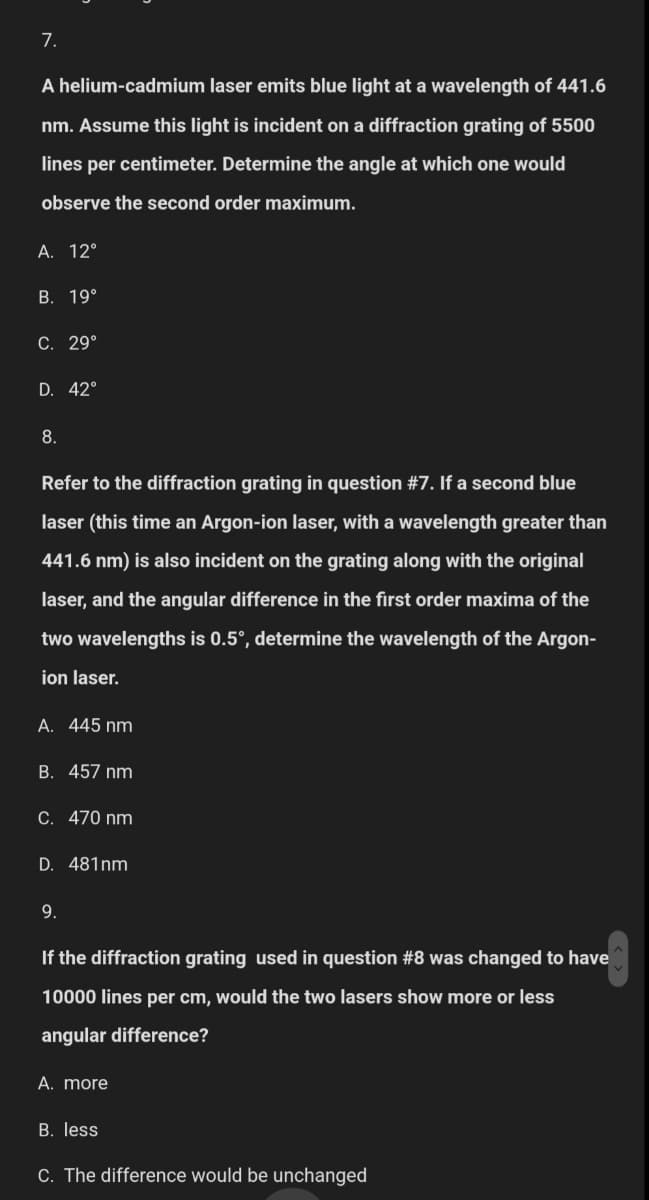7. A helium-cadmium laser emits blue light at a wavelength of 441.6 nm. Assume this light is incident on a diffraction grating of 5500 lines per centimeter. Determine the angle at which one would observe the second order maximum. A. 12° B. 19° C. 29° D. 42°
7. A helium-cadmium laser emits blue light at a wavelength of 441.6 nm. Assume this light is incident on a diffraction grating of 5500 lines per centimeter. Determine the angle at which one would observe the second order maximum. A. 12° B. 19° C. 29° D. 42°
Physics for Scientists and Engineers with Modern Physics
10th Edition
ISBN:9781337553292
Author:Raymond A. Serway, John W. Jewett
Publisher:Raymond A. Serway, John W. Jewett
Chapter37: Diffraction Patterns And Polarization
Section: Chapter Questions
Problem 49AP: Two closely spaced wavelengths of light are incident on a diffraction grating. (a) Starting with...
Related questions
Question
PLEASE SOLVE THESE I NEED HELP!!

Transcribed Image Text:7.
A helium-cadmium laser emits blue light at a wavelength of 441.6
nm. Assume this light is incident on a diffraction grating of 5500
lines per centimeter. Determine the angle at which one would
observe the second order maximum.
A. 12°
B. 19°
C. 29°
D. 42°
8.
Refer to the diffraction grating in question #7. If a second blue
laser (this time an Argon-ion laser, with a wavelength greater than
441.6 nm) is also incident on the grating along with the original
laser, and the angular difference in the first order maxima of the
two wavelengths is 0.5°, determine the wavelength of the Argon-
ion laser.
A. 445 nm
B. 457 nm
C. 470 nm
D. 481nm
9.
If the diffraction grating used in question #8 was changed to have
10000 lines per cm, would the two lasers show more or less
angular difference?
A. more
B. less
C. The difference would be unchanged
Expert Solution
This question has been solved!
Explore an expertly crafted, step-by-step solution for a thorough understanding of key concepts.
This is a popular solution!
Trending now
This is a popular solution!
Step by step
Solved in 4 steps

Knowledge Booster
Learn more about
Need a deep-dive on the concept behind this application? Look no further. Learn more about this topic, physics and related others by exploring similar questions and additional content below.Recommended textbooks for you

Physics for Scientists and Engineers with Modern …
Physics
ISBN:
9781337553292
Author:
Raymond A. Serway, John W. Jewett
Publisher:
Cengage Learning

Physics for Scientists and Engineers
Physics
ISBN:
9781337553278
Author:
Raymond A. Serway, John W. Jewett
Publisher:
Cengage Learning

Physics for Scientists and Engineers, Technology …
Physics
ISBN:
9781305116399
Author:
Raymond A. Serway, John W. Jewett
Publisher:
Cengage Learning

Physics for Scientists and Engineers with Modern …
Physics
ISBN:
9781337553292
Author:
Raymond A. Serway, John W. Jewett
Publisher:
Cengage Learning

Physics for Scientists and Engineers
Physics
ISBN:
9781337553278
Author:
Raymond A. Serway, John W. Jewett
Publisher:
Cengage Learning

Physics for Scientists and Engineers, Technology …
Physics
ISBN:
9781305116399
Author:
Raymond A. Serway, John W. Jewett
Publisher:
Cengage Learning

College Physics
Physics
ISBN:
9781285737027
Author:
Raymond A. Serway, Chris Vuille
Publisher:
Cengage Learning

College Physics
Physics
ISBN:
9781305952300
Author:
Raymond A. Serway, Chris Vuille
Publisher:
Cengage Learning

College Physics
Physics
ISBN:
9781938168000
Author:
Paul Peter Urone, Roger Hinrichs
Publisher:
OpenStax College